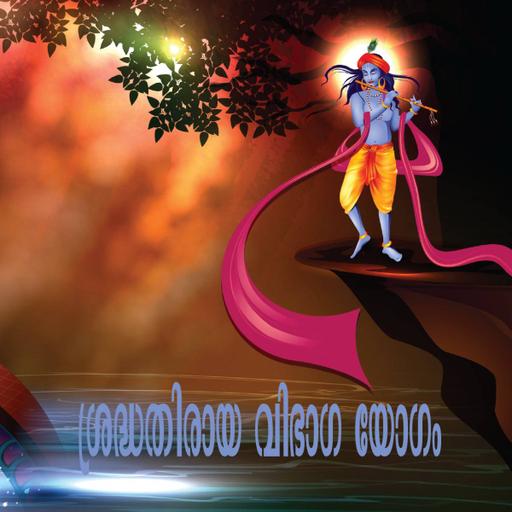Chapter17 - Shraddhatraya-Vibhaga yoga
Audio | Malayalam
In the chapter Shraddhatraya Vibhag Yog, Shree Krishna goes deeper into the three gunas or modes of material nature and how they govern human behaviour. He begins by discussing religion as an inextricable part of human nature and asserting that everyone has faith. However, their faith takes on a different hue depending on the makeup of their mind: sattvic, rajasic, or tamasic. The nature of their faith, including the cuisine they prefer to eat, determines the quality of their lives. Shree Krishna then proceeds on to the issue of yajna (sacrifice), explaining that sacrifice can take several forms depending on the modes of nature. He also talks about tapah (austerity) and how to be austere in your speech, body, and mind. Shree Krishna describes the meaning and significance of the words "Om Tat Sat" near the end of this chapter, and how they can usher in the concept of transcendence. The word "Om" symbolises God's impersonal form; the syllable "tat" is used to dedicate ceremonies and activities to the Supreme Lord; and the syllable "sat" represents eternal virtue and goodness. These words represent many facets of the Absolute Truth when put together. Shree Krishna emphasises at the end of this chapter that deeds of sacrifice, discipline, and charity conducted without faith and without consideration for the scriptures' guidelines are meaningless.
"ശ്രദ്ധാത്രയവിഭാഗയോഗം എന്ന ഈ അധ്യായത്തിൽ, ശ്രീ കൃഷ്ണൻ ഭൌതിക പ്രകൃതിയുടെ മൂന്ന് ഗുണങ്ങളിലേക്കോ വിഭാഗങ്ങളിലേക്കോ മനുഷ്യന്റെ പെരുമാറ്റത്തെ എങ്ങനെ ഭരിക്കുന്നുവെന്ന് കൂടുതൽ ആഴത്തിൽ പോകുന്നു. മതത്തെ മനുഷ്യപ്രകൃതിയുടെ അവിഭാജ്യ ഘടകമായി ചർച്ച ചെയ്യുകയും എല്ലാവർക്കും വിശ്വാസമുണ്ടെന്ന് ഉറപ്പിക്കുകയും ചെയ്തുകൊണ്ടാണ് അദ്ദേഹം ആരംഭിക്കുന്നത്. എന്നിരുന്നാലും, അവരുടെ മനസ്സിന്റെ രൂപഘടനയെ ആശ്രയിച്ച് അവരുടെ വിശ്വാസം വ്യത്യസ്തമായ നിറം കൈക്കൊള്ളുന്നു. സാത്വികം, രാജസിക്, അല്ലെങ്കിൽ താമസം എന്നിവയാണത്. അവർ കഴിക്കാൻ ഇഷ്ടപ്പെടുന്ന ഭക്ഷണവിഭവങ്ങൾ ഉൾപ്പെടെയുള്ള അവരുടെ വിശ്വാസത്തിന്റെ സ്വഭാവം അവരുടെ ജീവിതത്തിന്റെ ഗുണനിലവാരം നിർണ്ണയിക്കുന്നു. തുടർന്ന് ശ്രീ കൃഷ്ണൻ യജ്ഞത്തിന്റെ (യാഗം) വിഷയത്തിലേക്ക് നീങ്ങുന്നു.പ്രകൃതിയുടെ രീതികൾക്കനുസരിച്ച് ത്യാഗത്തിന് പല രൂപങ്ങളുണ്ടാകുമെന്ന് വിശദീകരിക്കുന്നു. തപഃ (തപസ്സ്) എന്നിവയെക്കുറിച്ചും നിങ്ങളുടെ സംസാരത്തിലും ശരീരത്തിലും മനസ്സിലും എങ്ങനെ സൂക്ഷ്മത പാലിക്കണം എന്നതിനെക്കുറിച്ചും അദ്ദേഹം സംസാരിക്കുന്നു. ഈ അധ്യായത്തിന്റെ അവസാനത്തിൽ ""ഓം തത് സത്"" എന്ന പദത്തിന്റെ അർത്ഥവും പ്രാധാന്യവും അവ എങ്ങനെ അവതരിപ്പിക്കാമെന്നും ശ്രീ കൃഷ്ണൻ വിവരിക്കുന്നു. അതിരുകടന്ന ആശയം. ""ഓം"" എന്ന വാക്ക് ദൈവത്തിന്റെ വ്യക്തിത്വമില്ലാത്ത രൂപത്തെ പ്രതീകപ്പെടുത്തുന്നു. ചടങ്ങുകളും പ്രവർത്തനങ്ങളും പരമേശ്വരന് സമർപ്പിക്കാൻ ""തത്"" എന്ന അക്ഷരം ഉപയോഗിക്കുന്നു; ""സത്"" എന്ന അക്ഷരം ശാശ്വതമായ പുണ്യത്തെയും നന്മയെയും പ്രതിനിധീകരിക്കുന്നു. ഈ വാക്കുകൾ സമ്പൂർണ്ണ സത്യത്തിന്റെ പല വശങ്ങളെ പ്രതിനിധീകരിക്കുന്നു. ഈ അധ്യായത്തിന്റെ അവസാനത്തിൽ ശ്രീ കൃഷ്ണൻ വിശ്വാസമില്ലാതെയും വേദങ്ങളുടെ മാർഗ്ഗനിർദ്ദേശങ്ങൾ പരിഗണിക്കാതെയും നടത്തുന്ന ത്യാഗം, അച്ചടക്കം, ദാനധർമ്മങ്ങൾ എന്നിവ അർത്ഥശൂന്യം ആണെന്നാണ് ഊന്നിപ്പറയുന്നത് ."

Free
MP3 (1 Units)
Chapter17 - Shraddhatraya-Vibhaga yoga
Audio | Malayalam
